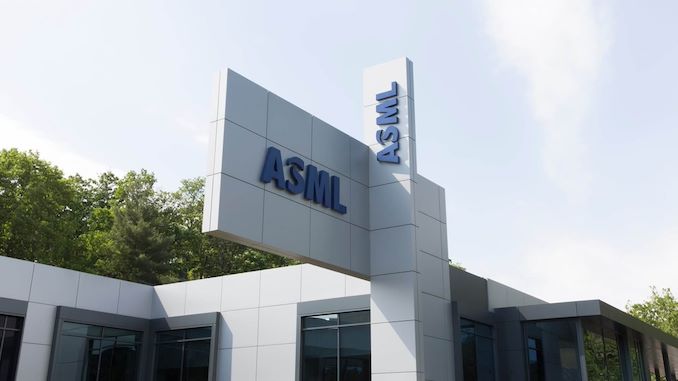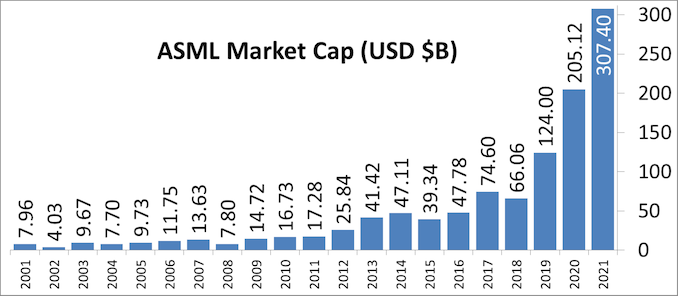Intel's Process Roadmap to 2025: with 4nm, 3nm, 20A and 18A?!
by Dr. Ian Cutress on July 26, 2021 5:00 PM ESTSidebar on Intel EUV
In all of these announcements, one thing to highlight is Intel mentioning its relationship with ASML, the sole company that manufactures the EUV machines powering production of leading edge semiconductor manufacturing.
ASML is a unique company in that it is the only one that can produce these machines, because the technology behind them is often tied up with its partners and research, but also because all the major silicon manufacturers are heavily invested in ASML. For any other company to compete against ASML would require building a separate network of expertise, a decade of innovation and design, and a lot of capital. None of the major silicon vendors want to disturb this balance and go off on their own, lest it shuts them out of the latest manufacturing technology, and no research fund sees competing against the embedded norm as a viable opportunity. This means that anyone wanting EUV specialist technology has to go to ASML.
In 2012, it was reported that Intel, Samsung, and TSMC all invested in ASML. This was, at the time, to jumpstart EUV development along with migrating from 300mm wafers to 450mm wafers. While we haven’t moved to 450mm wafers yet (and there are doubts we will any time in the next decade), EUV is now here. Intel’s 2012 investment of $2.1 billion gave them a 10% stake in ASML, with Intel stating that it would continue investing up to a 25% stack. Those stakes are now below the 5% reporting threshold, but all three of the major foundry customers are still big owners, especially as ASML’s market cap has risen from $24 Billion in 2012 to $268 Billion in 2021 (surpassing Intel).
As major investors but also ASML’s customers, the race has been on for these foundries to acquire enough EUV machines to meet demand. TSMC reported in August 2020 that it has 50% of all EUV machines manufactured at ASML for its leading edge processes. Intel is a little behind, especially as none of Intel’s products in the market yet use any EUV. EUV will only intercept Intel’s portfolio with its new Intel 4 process, where it will be used extensively, mostly on the BEOL. But Intel still has to order machines when they need them, especially as there are reports that ASML currently has backorders of 50 EUV machines. In 2021, ASML is expected to manufacture around 45-50 machines, and 50-60 in 2022. The exact number of machines Intel has right now, or has ordered from ASML, is unknown. It is expected that each one has a ~$150m price tag, and can take 4-6 months to install.
With all that being said, Intel’s discussion point today is that it will be the lead customer for ASML’s next generation EUV technology known as High-NA EUV. NA in this context relates to the ‘numerical aperture’ of the EUV machine, or to put simply, how wide you can make the EUV beam inside the machine before it hits the wafer. The wider the beam before you hit the wafer, the more intense it can be when it hits the wafer, which increases how accurately the lines are printed. Normally in lithography to get better printed lines, we move from single patterning to double patterning (or quad patterning) to get that effect, which decreases yield. The move to High-NA would mean that the ecosystem can stay on single patterning for longer, which some have quoted as allowing the industry to ‘stay aligned with Moore’s Law longer’.
| ASML's EUV Shipments | |||||||||||||||||||||
| 2015 | 2016 | 2017 | 2018 | 2019 | 2020 | 2021 | |||||||||||||||
| Actual | 2 | 4 | 10 | 3 | 4 | 5 | 6 | 4 | 7 | 7 | 8 | 4 | 7 | 14 | 8 | 7 | 9 | - | - | ||
| Target (Total) | - | - | - | 20 (18) | 30 (26) | 35 (33) | 45-50 | ||||||||||||||
| 2018 and beyond is split per quarter for actual shipped numbers Data taken from ASML's Financial Reports |
|||||||||||||||||||||
Current EUV systems are NA 0.33, while the new systems are NA 0.55. ASML’s latest update suggests that it expects customers to be using High-NA for production in 2025/2026, which means that Intel is likely going to be getting the first machine (ASML NXE:5000 we think) in mid-2024. Exactly how many High-NA machines ASML intends to produce in that time frame is unknown, as if they flood the market, having the first won’t be a big win. However if there is a slow High-NA ramp, it will be up to Intel to capitalize on its advantage.













326 Comments
View All Comments
Lord of the Bored - Thursday, July 29, 2021 - link
Right, but officially, Taiwan is still officially the Republic of China(the pre-communist name for the country). They didn't LEAVE.Both Taiwan and Mainland Taiwan claim they are the one true chinese government and the other side is a bunch of traitorous usurpers.
I do get the point, I just enjoy poking at mainland Taiwan.
mode_13h - Sunday, August 1, 2021 - link
> Both Taiwan and Mainland Taiwan claim they are the one true chinese government> and the other side is a bunch of traitorous usurpers.
I knew a guy who was an officer in the Taiwanese military, back in the 90's. At that time, he said their mantra was "we will go back" (to the mainland). These days, I can't imagine anyone would even say such things. From what I can tell, Taiwan is pretty content with the status quo, and would prefer it stay that way (within reason).
There are some downsides to not having formal independence. For instance, mainlanders can buy property in Taiwan. That's bidding up property values and is probably something they'd dare to regulate, if recognized as an independent country. Expensive real estate also increases the cost of doing business, which is one reason many young Taiwanese are moving to the mainland to start their careers.
mode_13h - Tuesday, July 27, 2021 - link
> No one thought TSMC would take a leadership when their 20nm was considered dud 7 years ago.Yeah, but they're only leading because Intel fell on its face. Had it continued to execute anything like it did up to 14 nm, they'd still be leading today.
Also, didn't hurt that GloFo stopped at 12 nm.
TheinsanegamerN - Tuesday, July 27, 2021 - link
So in the absence of any competition TSMC has managed to put out not one but two great nodes, with a third on the way.Somehow this means TSMC is bad while the competition is better LMFAO.
mode_13h - Wednesday, July 28, 2021 - link
> Somehow this means TSMC is bad while the competition is better LMFAO.What I'm doing is comparing Intel's old roadmaps to where TSMC is, today. It doesn't diminish TSMC's accomplishments.
With that said, TSMC certainly benefitted from Intel's missteps, because a less dominant Intel creates more demand for alternatives. And most of those alternatives, be they x86 or ARM, are manufactured by TSMC. That gave TSMC more revenue to fuel further R&D and continue improving their manufacturing process.
Spunjji - Thursday, July 29, 2021 - link
Why does it have to be about who is "bad"? It's literally just a discussion of what /is/.Machinus - Tuesday, July 27, 2021 - link
TSMC also invested heavily in expertise and manufacturing. Intel had to fuck up and TSMC had to get better for Intel to have such a massive failure that they lost their lead. TSMC is increasing their lead, market share, capacity...there is no way in hell Intel is going to "catch up" anytime soon.Spunjji - Thursday, July 29, 2021 - link
@Machinus - it's not *likely*, but it's not impossible either. If (big if!) Intel hit their targets for the "4" process then they'll recover a lot of the lead they lost already. If, in the meantime, any of TSMC's bets don't pay off - e.g. no GAA at 3nm (remember, no FinFet at 20nm was their last big L) - then no amount of money is going to magically fix that for them.Like I said, I don't think it's likely. I do think it's likely that Intel will gain enough ground for it to be functionally irrelevant, though.
Spunjji - Thursday, July 29, 2021 - link
It still wasn't apparent as recently as their 10nm, which was like a less dramatic repeat of 20nm. It really wasn't until TSMC rolled out 7nm that they had a process which was consistently outperforming Intel on all relevant metrics - density, power, switching performance, yield.Easy to claim things are obvious / impossible when we look backwards, isn't it :D
Kevin G - Monday, July 26, 2021 - link
It is possible as they are getting the better EUV first from ASML. That'll be a strategic advantage over the other foundries.Two questions remain: how much did Intel have to pay to get those first? Secondly, can Intel get the rest of their processor roadmap in line prior to receiving those critical machines?